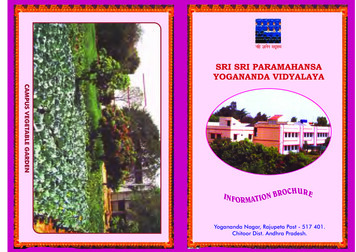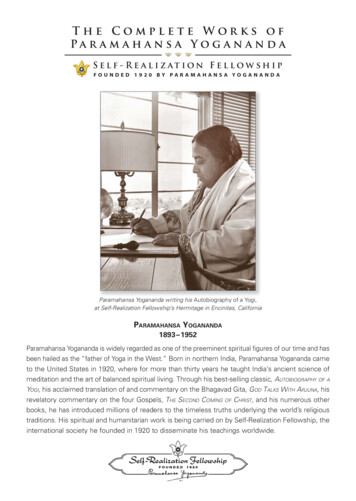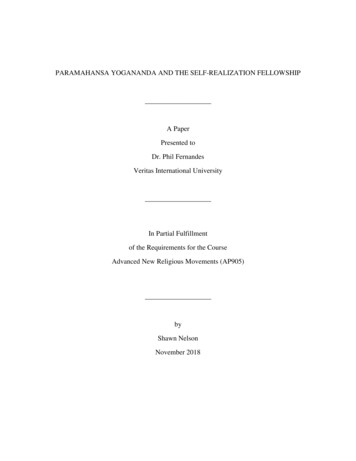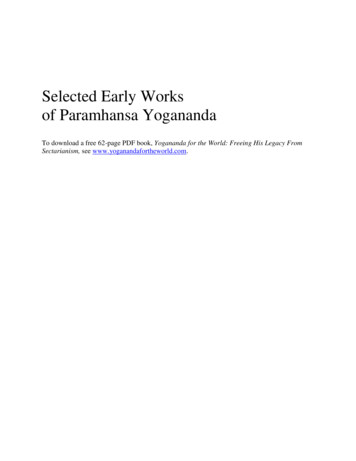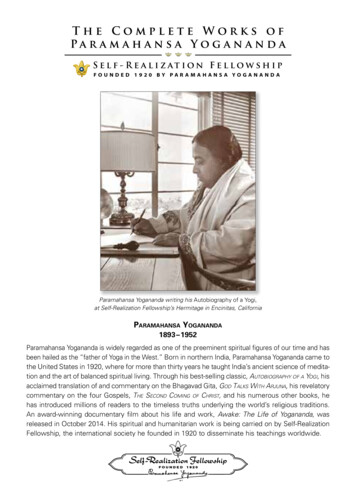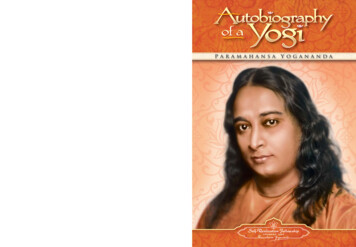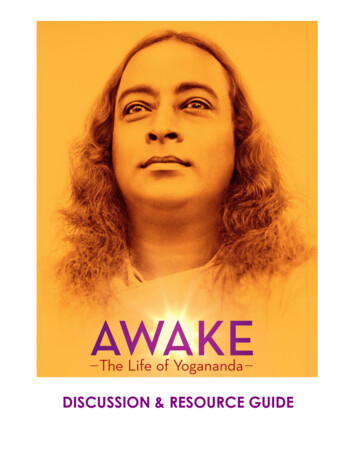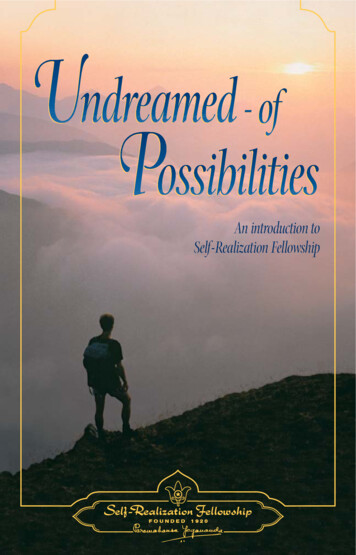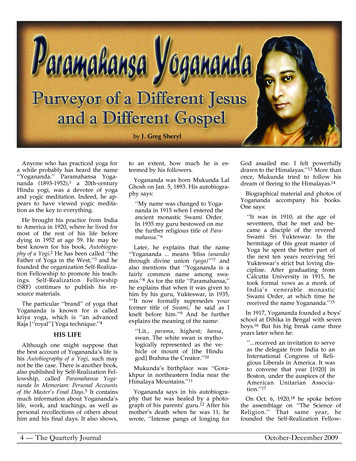
Transcription
Anyone who has practiced yoga fora while probably has heard the name‘‘Yogananda.’’ Paramahansa Yogananda (1893-1952),1 a 20th-centuryHindu yogi, was a devotee of yogaand yogic meditation. Indeed, he appears to have viewed yogic meditation as the key to everything.He brought his practice from Indiato America in 1920, where he lived formost of the rest of his life beforedying in 1952 at age 59. He may bebest known for his book, Autobiography of a Yogi.2 He has been called ‘‘theFather of Yoga in the West,’’3 and hefounded the organization Self-Realization Fellowship to promote his teachings. Self-Realization Fellowship(SRF) continues to publish his resource materials.The particular ‘‘brand’’ of yoga thatYogananda is known for is calledkriya yoga, which is ‘‘an advancedRaja [‘‘royal’’] Yoga technique.’’4HIS LIFEAlthough one might suppose thatthe best account of Yogananda’s life ishis Autobiography of a Yogi, such maynot be the case. There is another book,also published by Self-Realization Fellowship, called Paramahansa Yogananda In Memoriam: Personal Accountsof the Master’s Final Days.5 It containsmuch information about Yogananda’slife, work, and teachings, as well aspersonal recollections of others abouthim and his final days. It also shows,4 · The Quarterly Journalto an extent, how much he is esteemed by his followers.Yogananda was born Mukunda LalGhosh on Jan. 5, 1893. His autobiography says:‘‘My name was changed to Yogananda in 1915 when I entered theancient monastic Swami Order.In 1935 my guru bestowed on methe further religious title of Paramahansa.’’6Later, he explains that the name‘‘Yogananda . means ‘bliss (ananda)through divine union (yoga)’’’7 andalso mentions that ‘‘Yogananda is afairly common name among swamis.’’8 As for the title ‘‘Paramahansa,’’he explains that when it was given tohim by his guru, Yukteswar, in 1935,‘‘‘It now formally supersedes yourformer title of Swami,’ he said as Iknelt before him.’’9 And he furtherexplains the meaning of the name:‘‘Lit., parama, highest; hansa,swan. The white swan is mythologically represented as the vehicle or mount of [the Hindugod] Brahma the Creator.’’10Mukunda’s birthplace was ‘‘Gorakhpur in northeastern India near theHimalaya Mountains.’’11Yogananda says in his autobiography that he was healed by a photograph of his parents’ guru.12 After hismother’s death when he was 11, hewrote, ‘‘Intense pangs of longing forGod assailed me. I felt powerfullydrawn to the Himalayas.’’13 More thanonce, Mukunda tried to follow hisdream of fleeing to the Himalayas.14Biographical material and photos ofYogananda accompany his books.One says:‘‘It was in 1910, at the age ofseventeen, that he met and became a disciple of the reveredSwami Sri Yukteswar. In thehermitage of this great master ofYoga he spent the better part ofthe next ten years receiving SriYukteswar’s strict but loving discipline. After graduating fromCalcutta University in 1915, hetook formal vows as a monk ofIndia’s venerable monasticSwami Order, at which time hereceived the name Yogananda.’’15In 1917, Yogananda founded a boys’school at Dihika in Bengal with sevenboys.16 But his big break came threeyears later when he:’’.received an invitation to serveas the delegate from India to anInternational Congress of Religious Liberals in America. It wasto convene that year [1920] inBoston, under the auspices of theAmerican Unitarian Association.’’17On Oct. 6, 1920,18 he spoke beforethe assemblage on ‘‘The Science ofReligion.’’ That same year, hefounded the Self-Realization Fellow-October-December 2009
ship in the United States.19 This wasthe American counterpart to the Yogoda Satsanga Society of India, whichhe had founded in 1917.‘‘For the next several years, helectured and taught on the Eastcoast and in 1924 embarked on across-continental speaking tour.In Los Angeles, he began a twomonth series of lectures andclasses in January of 1925. Aselsewhere, his talks were greetedwith interest and acclaim.’’20Also in 1925, the InternationalHeadquarters of SRF was establishedin Los Angeles, Calif.21 It is still inLos Angeles on top of Mount Washington.A volume containing some of hisspeeches says that on Jan. 28, 1925:‘‘The Los Angeles Times reported:‘The Philharmonic Auditoriumpresents the extraordinary spectacle of thousands being turnedaway an hour before the advertised opening. . Swami Yogananda is the attraction. A Hinduinvading the United States tobring God in the midst of aChristian community, preachingthe essence of Christian doctrine.’’’22This same volume states:‘‘In the early 1930’s Paramahansaji began to withdraw graduallyfrom nationwide public lecturing. ‘I am not interested incrowds,’ he said, ‘but in soulswho are in earnest to know God.’Thereafter, he concentrated hisefforts on classes for serious students, and spoke mostly at hisown Self-Realization Fellowshiptemples and the internationalheadquarters.’’23Yogananda embarked on ‘‘an eighteen-month tour of Europe and Indiain 1935-36,’’24 after which he returnedto the United States. In 1946, hepublished his now-famous Autobiography of a Yogi. He died of a heart attackon March 7, 1952, while giving aspeech. He had turned 59 two monthsearlier.After he died — for the 20 days thathis body remained unentombed — hisOctober-December 2009body exhibited no physical signs ofdecay, a fact attested to in a writtenstatement (which was also notarized)given by Harry T. Rowe, the Mortuary Director of the Forest Lawn Memorial-Park Association, who stated:‘‘The absence of any visual signsof decay in the dead body ofParamhansa Yogananda offersthe most extraordinary case inour experience.’’25The document further stated:‘‘The physical appearance ofParamhansa Yogananda onMarch 27th, just before thebronze cover of the casket wasput into position, was the sameas it had been on March 7th. Helooked on March 27th as freshand as unravaged by decay as hehad looked on the night of hisdeath. On March 27th there wasno reason to say that his bodyhad suffered any visible physicaldisintegration at all. For thesereasons we state again that thecase of Paramhansa Yoganandais unique in our experience.’’26Then, ‘‘In 1977, on the twenty-fifthanniversary of the [death] of Paramahansa Yogananda, the Government ofIndia issued [a] commemorativestamp in his honor.’’27The most recent edition and printing of Autobiography of a Yogi 28 embellishes the cover photograph of Yogananda by placing a nimbus (a halo oflight) around his head.FAMOUS PEOPLEBy the time of his death, ‘‘Yogananda [had] personally initiated over100,000 students into kriya yoga.’’29Among those he initiated wasMahatma Gandhi30 and horticulturalist Luther Burbank,31 to whom hededicated Autobiography of a Yogi.The Self-Realization FellowshipWebsite reports:‘‘Among those who became hisstudents were many prominentfigures in science, business, andthe arts, including horticulturistLuther Burbank, operatic soprano Amelita Galli-Curci,George Eastman (inventor of theKodak camera), poet EdwinMarkham, and symphony conductor Leopold Stokowski. In1927, he was officially received atthe White House by PresidentCalvin Coolidge, who had become interested in the newspaperreports of his activities.’’32Another source states:‘‘The most popular lay ministerat the Los Angeles headquarters[of Self-Realization Fellowship] istelevision star Dennis ‘McCloud’Weaver, an SRF disciple for some40 years.’’33Dennis Weaver died in 2006.HIS WORKYogananda was a Hindu despite hisapparent respect for Jesus and theBible. Christian apologists JohnAnkerberg and John Weldon observe:‘‘SRF claims religious toleranceand pluralism, and even to beChristian. However the essentially Hindu outlook of SRF isillustrated in Yogananda’s definition of ‘self-realization’ as therecognition of our own divinity.It is ‘The knowing — in body,mind, and soul — that we areone with the omnipresence ofGod; that we do not have to praythat it comes to us, that we arenot merely near it at all times,but that God’s omnipresence isour omnipresence. .’ The essential beliefs of SRF parallel Vedantic Hinduism in the monistic, ornon-dualist (advaita) tradition.’’34Another example is found in avolume of Yogananda’s speecheswhere it states:‘‘His Holiness the Shankaracharya of Kanchipuram, reveredspiritual leader of millions inSouth India, wrote of Paramahansaji: ’. We are grateful toYogananda for spreading Hinduphilosophy in such a wonderfulway in America and the West.’’’35Autobiography of a Yogi was firstpublished in 1946 and was expandedby him before his death.36 It is adangerous book because it is anattractively packaged presentation ofThe Quarterly Journal · 5
Hinduism and it promotes anti-Christian doctrines of astrology, idolatry,reincarnation, contacting the dead,and so forth.Another book by Yogananda, TheSecond Coming of Christ: The Resurrection of the Christ Within You,40 is a setof teachings by Yogananda on thefour New Testament Gospels. It issubtitled, ‘‘A revelatory commentaryon the original teachings of Jesus.’’These commentaries were developedfrom articles Yogananda had writtenfor the Self-Realization Fellowship’smagazine. Yogananda claims that theexpertise to write such a commentarycame ‘‘by revelation.’’ Yogananda describes the source of his revelation:Yogananda says this about the passage:‘‘He [Jesus] approved verydearly and blessed me for writing these interpretations. This Ican say without pride, becausethe interpretation of Christ’swords herein is not mine. It hasbeen given to me. I am happythis book is coming through me;but I am not the author. It isChrist. I am only the vehiclethrough which it is explained. Ihear Christ in the land of myinspiration; I behold Christspeaking to me all the eternalwisdom he intended to conveywithin his pregnant words. Evenwhen urged by well-meaning Britishteachers in my youth, I never readthe New Testament, except for a fewpassages; for had I done so, theologyunder their tutelage would haveblinded my vision and prejudicedmy hearing, and I could not haveheard Christ’s voice or seen himspeak. Now I rejoice as I willalways long to rejoice to hearChrist speak to me his words oflife, truth, and eternal liberationfor all.’’41John 3:14-15: ‘‘And as Moses liftedup the serpent in the wilderness, evenso must the Son of Man be lifted up,that whoever believes in Him shouldnot perish but have eternal life.’’YOGANANDA, TELLME A STORY.Far from obliging man’s perverteddesire for miraculous signs, Jesusclearly stated:As one looks at his explanations ofpassages, it obviously wasn’t the living Christ or the Holy Spirit whoinspired his commentary. By forcingHindu philosophy into the Bible, Yogananda makes unrecognizable Scripture passages that are otherwise profound in their simplicity. Here are acouple of examples:‘‘A wicked and adulterous generation seeks after a sign, and nosign shall be given to it exceptthe sign of the prophet Jonah’’(Matthew 16:4).John 3:16: ‘‘For God so loved theworld that He gave His only begottenSon, that whoever believes in Himshould not perish but have everlasting life.’’The late Beatle, George Harrison, aHindu, said of Yogananda’s Autobiography:‘‘I keep stacks of Autobiography ofa Yogi around the house, and I giveit out constantly to people. Whenpeople need ‘regrooving,’ I say readthis, because it cuts to the heart ofevery religion.’’37But Ankerberg and Weldon writethat Autobiography of a Yogi ‘‘is repletewith occult experiences.’’38In addition to the promotion ofHinduism, occultism, and other antiChristian teachings in this book, it isvery difficult to locate the line separating truth from fiction; for some ofthe experiences he relates in it arepatently false on their surface.39On the book’s title page is John 4:48:‘‘Except ye see signs and wonders, yewill not believe.’’ To remedy thissituation, Yogananda’s solution is toserve up tale after tale of miraculousevents that he has heard of, experienced, and/or supposedly witnessed.This quotation from John’s Gospel isironic for a couple of reasons:First, Yogananda doesn’t actually‘‘show’’ us any miraculous signs andwonders; he merely relates them, andwe must decide whether or not tobelieve him. Many of the things hedescribes simply could not have occurred.Second, in context, the words Yogananda quotes from the Gospel of Johnare a reproach of the Lord to anobleman, who wants Jesus to healhis dying son. Jesus complies with theman’s request, apparently with reluctance. This is a far cry from the wayYogananda uses the verse.6 · The Quarterly Journal‘‘‘God so loved the world, thatHe gave His only begotten Son’to redeem it; that is, God theFather remained hidden beyondthe vibratory realm that went outfrom His Being, but then secretedHimself as the Christ Intelligencein all matter and in all livingbeings in order to bring, bybeautiful evolutional coaxings, allthings back to His home of Everlasting Blessedness.’’42Yogananda interprets this passagethis way:‘‘Jesus explains that whosoeverbelieves in the doctrine of liftingthe bodily consciousness (son ofman) from the physical to theastral by reversing the life forcethrough the coiled passage at thebase of the spine, will not perish,that is, be subject to mortalchanges of life and death, butwill gradually acquire the immutable state — Christ Consciousness, the Son of God.’’43Although Dr. Ronald B. Allen ofDallas Theological Seminary wasspeaking on a different subject, hiswords apply to this, when he said,‘‘This isn’t exegesis [determining themeaning of the text]; it isn’t [even]eisegesis [reading a meaning into thetext]; this is metagesis [changing thetext]!’’In Autobiography of a Yogi and elsewhere, Yogananda relates things thatare questionable, highly suspect, oreven patently false.In a letter written from the HolyLand, regarding some of his experiences there, Yogananda wrote:‘‘He [Jesus] was with me everywhere; and a very special communion I had in Bethlehemwhere he was born as the littleOctober-December 2009
babe body of Jesus. He touchedme as I entered the ancient menagerie where Mary brought himinto the world — in a humblelittle stable under an inn. Thisplace is absolutely authentic. Iknow it from the Divine. Butthere are other places where different factions have marked Jesusdid this and that, which havesome errors. Every place wasverified from within. Most placesare authentic.’’44In one talk, Yogananda declared:‘‘For most of his followers Christexists as an ideal personage theyhave read about in the Bible. Butto me he is much more than that.He is real. Once, eight years ago,he came alone and meditatedwith me all night long. . Manyother times I have seen him invisions, and talked with him.And that same Christ you toocan see.’’45‘‘Jesus attained most of his perfection in his former incarnationas Eliseus (Elisha). I know forcertain that he was Eliseus in apast life, and that Jesus’ guru,John the Baptist, was Elijah(Elias), in his former life.’’46‘‘We are all children of God.Many incarnations ago He created us as He created Jesus.’’47In one place, he describes a visionhe supposedly had of Jesus. In part,he wrote:‘‘As he gazed down at me, aHoly Grail appeared at hismouth. It descended to my lipsand touched them; then went upagain to Jesus. After a few moments of rapt silent communion,he said to me: ‘Thou dost drinkof the same cup of which Idrink.’’’48The ‘‘cup’’ that Jesus drank was thatof obeying the Father’s will by beingcrucified for our sins by the hands ofsinful men. Yogananda never dranksuch a cup. To be fair, Yoganandadoesn’t associate the ‘‘cup’’ with thismeaning; rather, he associates it witha reference to a cup in the Gnosticgospel of Thomas.October-December 2009SERIOUSLY SENIOR CITIZENSIn Autobiography, Yogananda tells ofpeople who are (or were) supposedlycenturies old. One of these was aguru, who probably never lived,named ‘‘Babaji.’’ Supposedly, this‘‘deathless guru,’’ as Yogananda refers to him, is still alive after manycenturies. He even is said to haveinitiated the Hindu philosopher Shankara into kriya yoga.49 Shankara livedaround the 9th century A.D. Thiswould make Babaji older than Methusaleh, the oldest man recorded in theBible, who ‘‘only’’ lived to be 969years old (Genesis 5:27). Additionally,Yogananda also tells of a TrailangaSwami, who was rumored to be over300 years old, weighed more than 300pounds, and went around naked.50Despite this, Yogananda incongruously refers to him as ‘‘the Christlikeyogi, Trailanga.’’51Without any hint that he might beputting us on, Yogananda writes,‘‘Mahavatar Babaji and a number ofother great masters have lived forseveral hundred years.’’52 He alsowrote of Babaji, ‘‘Babaji is ever incommunion with Christ; together theysend out vibrations of redemptionand have planned the spiritual technique of salvation for this age.’’53Christian author and researcherElliot Miller writes:‘‘Yogananda’s autobiography isreplete with accounts of the mystical and miraculous, includinghis own ecstatic visions as wellas his encounters with legendaryHindu ‘saints.’ . Most fantasticof all is his description of Babaji,the ‘yogi Christ of India,’ who —like the ‘Immortals’ in the 1990sHighlander movies and televisionseries — is believed to haveretained the same 25-year-old appearance for hundreds or eventhousands of years. Babaji allegedly initiated [Yogananda’sguru] Sri Yukteswar’s master,Lahiri Mahasaya, and thus gotthe SRF ball rolling. In the SRFvisitor center, a drawing of Babaji, which had been sketchedunder Yogananda’s supervision,accompanies photographs of Mahasaya and Yukteswar. Not sur-prisingly, although Yoganandasupposedly met Babaji and hisAutobiography is filled with pictures of the people (includingIndian gurus and ‘saints’) described in its pages, no knownphotograph of the ‘yogi Christ’exists.’’54Yogananda’s Autobiography also informs us:‘‘Babaji (revered father) is a common title; many noted teachers inIndia are addressed as ‘Babaji.’None of them, however, is [the]Babaji [referred to here]. . Theexistence of [Babaji] was revealedto the public for the first time in1946, in Autobiography of aYogi.’’55Consistent with this assertion, wealso read therein:‘‘That there is no historical reference to Babaji need not surpriseus. The great guru has neveropenly appeared in any century;the misinterpreting glare of publicity has no place in his millennial plans. Like the Creator, thesole but silent Power, Babajiworks in a humble obscurity. .Such masters always veil themselves from the gross public gazeand have the power to becomeinvisible at will. For these reasons, and because they generallyinstruct their disciples to maintain silence about them, a number of towering spiritual figuresremain world-unknown. I give inthese pages on Babaji merely ahint of his life — only a few factsthat he deems fitting and helpfulto be publicly imparted.’’56So we must rely on Yogananda’sassertion that Babaji exists — like somany other events in Yogananda’sAutobiography. Nevertheless, Yoganada contradicts himself about Babaji’s supposed desire to be hiddenfrom the public’s gaze only threepages later when he writes:‘‘Only one reason, therefore, motivates Babaji in maintaining hisphysical form from century tocentury: the desire to furnishhumanity with a concrete example of its own possibilities.The Quarterly Journal · 7
Were man never vouchsafed aglimpse of Divinity in the flesh,he would remain oppressed bythe heavy mayic delusion that hecannot transcend his mortality.’’57Yogananda cannot have it bothways. Babaji must either wish toavoid the public stare or to showhimself to the public to help theirenlightenment.In Yogananda’s Autobiography, wefind tales of supposedly historicalevents involving materializations ofextra bodies, materializations oflunches on gold plates, materialization of a palace in the Himalayas, etc.Flesh and blood resurrections of deadpeople and materializations of livingpeople in the book become almostcommonplace. In one place (accordingto a story that his guru, Yukteswar,supposedly related), an old, limpingman, who was a yogi, suddenly‘‘straightened himself; his body instantly became strong and youthful.’’58 On another occasion, Yogananda’s recently deceased guru, Yukteswar, appears in ‘‘flesh and blood’’in order to give him a lengthy discourse on the afterlife.59 His guruexplains in part:‘‘‘As the prophets are sent onearth to help men work out theirphysical karma, so I have beendirected by God to serve on anastral planet as a savior,’ SriYukteswar explained. ‘It is calledHiranyaloka or ‘‘Illumined AstralPlanet.’’ There I am aiding advanced beings to rid themselvesof astral karma and thus attainliberation from astral rebirths.’’’60The Scriptures warn us to beware ofsuch people when it says:‘‘By covetousness they will exploit you with deceptive words;for a long time their judgmenthas not been idle, and theirdestruction does not slumber’’(2 Peter 2:3).The New International Version hasa particularly vivid translation of thefirst part of this verse. It reads, ‘‘Intheir greed these teachers will exploityou with stories they have made up.’’Unfortunately, it is not always easy totell what actually occurred in his8 · The Quarterly JournalAutobiography and what did not, orwhat was embellished or exaggerated.worshiped various Hindu gurus andHindu ‘‘saints’’:YOGANANDA’S DOCTRINES‘‘We are all part of the OneSpirit. When you experience thetrue meaning of religion, whichis to know God, you will realizethat He is your Self, and that Heexists equally and impartially inall beings.’’63Yogananda believed in and taughtthe Hindu doctrines of karma (the lawof cause-and-effect) and reincarnation.He also proclaimed the Hindu doctrine of the material world being maya(an illusion; delusion). He also taughtyoga.God and Man: Yogananda believedin a Supreme Being. It wasn’t thebiblical God, but the Hindu godBrahman. He believed Brahman wasan impersonal being but greater thanman, and man was a manifestation ofBrahman. He wrote:‘‘The wave cannot say, ‘I am theocean,’ for the ocean can remainwithout the wave, but the wavecannot remain without the ocean.It is all right for a fully liberatedmaster to say, ‘God has becomemyself,’ but he would never say,‘I am God.’ The ocean has become the wave, but the wave isnot the ocean.’’61‘‘Hinduism as well as Christianity believes in one God. . Uninformed Westerners conclude thatIndians as a whole worship idols.But we worship only Brahman,Spirit. The concept of one God isthe same in Hinduism as inChristianity.’’62It is true that some Hindus believe inone God; some Hindus believe inmany gods; and some Hindus areatheists, believing in no God. Andregardless of whether a particularHindu is a monotheist or not, Brahman is assuredly not the God andFather of our Lord Jesus Christ! AsJames reminds us, ‘‘You believe thatthere is one God. You do well. Eventhe demons believe — and tremble!’’(James 2:19) Being a monotheist, inand of itself, doesn’t qualify one forsalvation. However, Brahman is notthe biblical God. And many, if notmost, Hindus worship more than onegod. Yogananda himself worshipped‘‘the Divine Mother,’’ although hemay have considered her to be merelyone aspect of Brahman, rather than aseparate deity. In any event, from hisAutobiography it is evident that he alsoAs he stated in one of the quotations above, Yogananda believed thatGod has become each being. In otherwords, Yogananda was a pantheist:He believed that God was everything.This is certainly not the Christianconcept of God, and contradicts hisassertion in the quotation above,where he claimed that the Christianconcept of one God was the same asthe Hindu concept of one God. TheChristian God is separate from Hiscreation, not identical with it. Yogananda wrote:‘‘Befriend the Self and the Selfwill save you. There is no othersavior than your Self. . Seize theGod within you and realize thatthe Self is Divinity.’’64Sin: Yogananda’s exalted view ofman led to a defective view of man’sprimary problem. He wrote:‘‘Man only increases the innerdarkness of his spiritual ignorance when he thinks of himselfas a sinner.’’65‘‘Through use of the Kriya [yoga]key, persons who cannot bringthemselves to believe in the divinity of any man will behold atlast the full divinity of their ownselves.’’66A problem that often arises withYogananda’s Hindu description ofman’s problem is the notion thatpeople have to ‘‘work off’’ somethingduring their multiple lives beforebreaking out of the cycle of reincarnation.Yogananda attributes man’s sins to‘‘ignorance,’’ and explains it this way:‘‘Then why do people behave inan evil way that is bound tocause pain and sorrow? Suchactions arise from the greatest ofall sins — ignorance. ‘Wrong-October-December 2009
doer’ is the right word ratherthan ‘sinner.’ You may condemnwrongdoing but should not condemn the doer. Sins are errorscommitted under the influence ofignorance, or delusion. But for adifferent degree of understanding, you might be in the sameboat.’’67Yogananda — and Hinduism ingeneral — teaches that man is ignorant of his ‘‘true identity’’ of beingone with ‘‘God’’ (the Hindu supremedeity Brahman).Yogananda doesn’t deny the existence of sin. However, he calls ignorance ‘‘the greatest of all sins,’’ andimplies that all other sins flow fromthis. Notice also the non-existent distinction Yogananda makes in theabove citation between ‘‘wrongdoer’’and ‘‘sinner.’’68 And he also admitsthat people may behave in ‘‘an evilway’’ and commit ‘‘wrongdoing’’ and‘‘sins.’’ Yet he somehow wishes toexempt such a person from beinglabeled a ‘‘sinner.’’ People who sin —and that is all of us as Romans 3:23declares — are sinners.As he does with most problems,Yogananda proposes meditation asthe solution:‘‘While still in this body, work todestroy the seeds of your pastkarmas (actions). Remember,roasted seeds will not germinate.People who in deep meditationroast their karmic seeds in thefires of wisdom will never againneed to reincarnate on earth.’’69In other words, to stop the cycle ofreincarnation, people have to pay offtheir ‘‘karmic debt.’’ It should benoted that Hinduism does recognizegood karma as well as bad karma.However, it emphasizes bad karma.70The Holy Spirit is not an ‘‘it,’’ butthe one personal God — the thirdPerson of the Trinity. He demonstrates the traits of personality: Heloves (Romans 15:30); can speak (Acts28:25; Hebrews 3:7; Revelation 22:17);can be grieved (Ephesians 4:30); canbe lied to (Acts 5:3); can be insulted(Hebrews 10:29); can be resisted (Acts7:51); can be blasphemed against(Mark 3:29), and so forth.Jesus and Christianity: At times,Yogananda seems full of reverence forJesus. He can even refer to ‘‘theblessed Lord Jesus.’’72 He obviouslyadmired Him, and sought to makehim a divine guru, even incorporatingJesus as one of the six gurus ofSelf-Realization Fellowship, withKrishna and himself being two of theothers.Part of the problem with Yogananda’s view of Jesus is that he didn’tunderstand the uniqueness of Jesus.Hinduism can accept Jesus as one ofmany gods, even as Yoganandaplaced Jesus on the same level as themythological god Krishna. Gandhi,whom Yogananda met and admired,well illustrates this problem that Hinduism has in accepting the uniqueand unparalleled deity of the LordJesus Christ. In his autobiography,The Story of My Experiments with Truth,Gandhi wrote:‘‘It was more than I could believethat Jesus was the only incarnateson of God, and that only hewho believed in him would haveeverlasting life. If God couldhave sons, all of us were Hissons. If Jesus was like God, orGod Himself, then all men werelike God and could be GodHimself. . I could accept Jesusas a martyr, an embodiment ofsacrifice, and a divine teacher,but not as the most perfect manever born.’’73The Holy Spirit: Yogananda appearsto view the Holy Spirit as a cosmicintelligent ‘‘It,’’ rather than the personal God:The Reverend Philip Graham Rykenobserved:‘‘The Holy Ghost is the CosmicIntelligent Vibration, whosesound is the Aum [i.e., OM] orAmen heard in deep yoga mediation. . In its vibration is ourcomfort.’’71‘‘Authentic, biblical Christianityhas always been an exclusivereligion. This became apparentduring the Roman Empire. Whenthe Emperor Alexander Severusheard about Christianity, heOctober-December 2009placed an image of Christ besidethe other gods in his privatechapel, just to be safe. The Romans were happy to welcomeJesus into their pantheon. Whatthe Romans could not understand was why Christians refused to reciprocate. If the emperor was willing to worshipChrist, why weren’t Christianswilling to worship the emperor?Yet the early Christians insistedthat in order to worship Christ atall, they had to worship Christalone. . Jesus Christ refuses tohave any colleagues.’’74And the Scriptures also declare:‘‘Jesus said to him [Thomas], ‘Iam the way, the truth, and thelife. No one comes to the Fatherexcept through Me’’’ (John 14:6).‘‘Nor is there salvation in anyother, for there is no other nameunder heaven given among menby which we must be saved’’(Acts 4:12).Again, to quote Ryken:‘‘To use an analogy, Jesus is likeGod’s telephone number. TheGod of the universe can only becontacted through Jesus Christ.Philosophical pluralists insist ongetting through to God no matterwhat number they dial. But thatis not how the telephone systemoperates, and it is not how Godoperates either. Jesus is the onlydirect line to God.’’75The Lord Jesus, being God in theflesh, is peerless. He has no equalsand no rivals. He is King of kings andLord of lords (see Revelation 19:16).THE DIFFERENT JESUSOF PARAMAHANSAYOGANANDAPart of Yogananda’s attitude aboutJesus is expressed in a book of excerpts of his teachings about Jesus.The title of the section of the book iscalled ‘‘Jesus the Christ — Avatar andYogi.’’76Yogananda wrote:‘‘‘Do you believe in the divinity ofChrist?’ a visitor inquired. Parama-The Quarterly Journal · 9
hansa Yogananda replied: ‘Yes. Ilove to talk of him because he was aman of perfect Self-realization. However, he was not the only son ofGod, nor did he claim to be. Instead,he cl
the best account of Yogananda’s life is his Autobiography of a Yogi, such may not be the case. There is another book, also published by Self-Realization Fel-lowship, called Paramahansa Yoga-nanda In Memoriam: Personal Accounts of the Master’s Final Days.5 It contains much informatio
